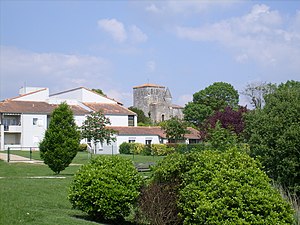Vaux-sur-Mer
| Vaux-sur-Mer | ||
|---|---|---|

|
|
|
| region | Nouvelle-Aquitaine | |
| Department | Charente-Maritime | |
| Arrondissement | Rochefort | |
| Canton | Royan | |
| Community association | Royan Atlantique | |
| Coordinates | 45 ° 39 ′ N , 1 ° 4 ′ W | |
| height | 0-27 m | |
| surface | 5.97 km 2 | |
| Residents | 3,798 (January 1, 2017) | |
| Population density | 636 inhabitants / km 2 | |
| Post Code | 17640 | |
| INSEE code | 17461 | |
| Website | www.vaux-sur-mer.com | |
 Vaux-sur-Mer - View of the town with Saint-Étienne church |
||
Vaux-sur-Mer is a southwestern French municipality with 3798 inhabitants (at January 1, 2017) in the department of Charente-Maritime in the region Nouvelle-Aquitaine .
location
Vaux-sur-Mer is located on the northeast bank of the Gironde , which is part of the historic cultural landscape of the Saintonge . The next larger city is Royan (about three kilometers to the southeast).
Population development
| year | 1962 | 1968 | 1975 | 1982 | 1990 | 1999 | 2008 | 2016 |
| Residents | 1368 | 1798 | 2163 | 2484 | 3054 | 3448 | 3738 | 3783 |
In 1800 Vaux-sur-Mer still had 320 inhabitants; thereafter the population of the place has grown steadily (1901: 537 inhabitants / 1954: 1,038 inhabitants), which is mainly due to the proximity to the city of Royan.
economy
Centuries ago agriculture and fishing played the dominant roles in the community's economic life. This is one of the Bons Bois of the Cognac wine-growing region , but because of the sales crisis for expensive brandies, hardly any wine is grown any more; the farmers in the area have returned to 'normal' agriculture. Since the 1960s, tourism has played a not insignificant role in the economic life of the place.
history
Formerly there were the ruins of two large stone graves ( dolmen ) in the municipality , but both of them disappeared for good in the 19th century; other prehistoric and Gallo-Roman finds have also been made. In 1075, Benedictine monks founded the Abbey of Saint-Étienne, which was destroyed for the first time almost 100 years later (1167) by Guibert de Didonne , a landlord ( seigneur ) who had become powerful . Shortly afterwards (1170) Pope Alexander III confirmed . in a bull the possessions of the abbey, to which in the meantime several churches and villages in the Saintonge belonged, including Thaims , Arces and Saint-Sulpice-de-Royan , so that they could have an annual income of about 3,000 gold florins . During the years of the great plague epidemic of 1348 , the monks left the abbey; after their resettlement (1418) the annual income was estimated at only 150 gold florins. During the wars of religion (1562–1598) Protestants occupied the abbey and destroyed it a second time - only the eastern section and parts of the walls of the nave remained. Since the last abbot of the monastery, the Abbé Castin de Guéris de la Magdelaine, refused to swear the oath on the revolutionary constitution , he was deported. Towards the end of the Second World War , the place suffered heavy damage again.
Attractions
See also: List of the Monuments historiques in Vaux-sur-Mer
- The Catholic parish church of Saint-Étienne formerly belonged to a medieval abbey, but only parts of it have survived due to the destruction during the Huguenot Wars. Monument historique since 1913.
- The former abbey church is surrounded by a medieval cemetery with an abundance of sarcophagi and tombs from all times. This cemetery has also been recognized as a monument historique since 1936 .
- Only a few meters away from the church is the former city palace of the landlord ( seigneur ) from the late 18th century; but it was not until the 19th century that it got its present form. Today the town hall ( mairie ) is housed there.
- The Protestant temple from 1847 used to stand on the outskirts. Compared to the other Protestant churches in the area, it is kept extremely simple and unadorned.
- In the 19th century, the seaside resort of Pontaillac was built on the territory of the municipalities of Vaux-sur-Mer and Royan, in which a simple neo-Romanesque chapel was also built.
Partner communities
literature
- Le Patrimoine des Communes de la Charente-Maritime. Flohic Editions, Volume 2, Paris 2002, ISBN 2-84234-129-5 , pp. 789-791.
Web links
- Vaux-sur-Mer, Église Saint-Étienne - Photos + information (French)
- Vaux-sur-Mer, Église Saint-Étienne - Photos + information (French)
- Vaux-sur-Mer, Église Saint-Étienne - Photos + information (French)
- Vaux-sur-Mer, Église Saint-Étienne - photos + brief information (French)
- Vaux-sur-Mer, Temple - Photos
Individual evidence
- ↑ Cimetière, Vaux-sur-Mer in the Base Mérimée of the French Ministry of Culture (French)





